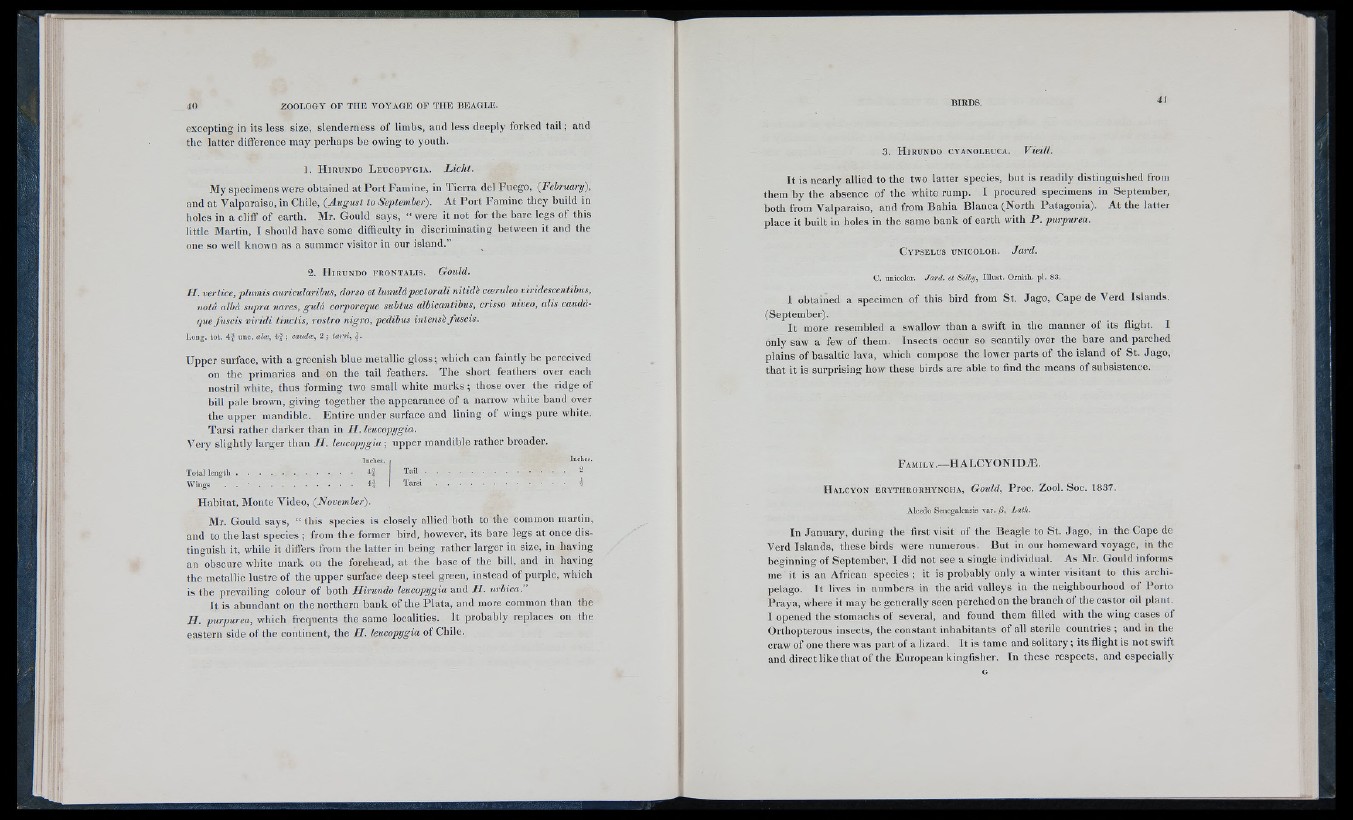
excepting in its less size, slenderness of limbs, and less deeply forked tail ; and
tlie latter difference may perhaps be owing to youth.
1 . H ir u n d o L e u c o p y g i a . Licht.
My specimens were obtained at Port Famine, in Tierra del Fuego, {February),
and at Valparaiso, in Ciiile, {August to September). At Port Famine they build in
holes in a cliff of earth. Mr. Gould says, “ were it not for the bare legs of this
little Martin, I should have some difficulty in discriminating between it and the
one so well known as a summer visitor in our island.”
2 . H ir u n d o f r o n t a l i s , Gould.
H. vertice, phimis auricularibus, dorso et lunulâpectorali nitidh cæruleo viridescentibus,
nota albâ supra nares, guUi corporeqiie subtus albicantibus, crisso niveo, alis caudci-
que fuscis viridi tinctis, rostro nigro, pedibus intensé fuscis.
Long. tot. 4 f line, aloe, 4 | ; cauda-, 2 ; tarsi,
Upper surface, with a greenish blue metallic gloss; wbicli can faintly be perceived
on the primaries and on the tail feathers. The short featliers over each
nostril wliite, thus forming two small white marks ; those over the ridge of
bill pale brown, giving togetlier tlie appearance of a narrow wliite band over
the upper mandible. Entire under surface and lining of wings pure white.
Tarsi ratlier darker tlian in II. leucopygia.
Very sliglitly larger than II. leucopygia ; upper mandible ratiier broader.
Inche..
Total lengtl............................................................. 4 i T a i l ................................................................................2
Wings . . ■ .................................................................. T a r a i ................................................................................
Habitat, Monte Video, {November).
Mr. Gould says, “ this species is closely allied both to the common martin,
and to the last species ; from the former bird, however, its bare legs at once distinguish
it, while it differs from tlie latter in being rather larger in size, in having
an obscure wliite mark on tiie forehead, at the base of the bill, and in having
tlie metallic lustre of the upper surface deep steel green, instead of purple, wliicli
is the prevailing colour of botli Hirundo leucopygia and H . urbica."
It is abundant on tlie northern bank of the Plata, and more common tlian tlie
H . purpurea, wliicli frequents the same localities, it probably replaces on the
eastern side of the continent, the H. leucopygia of Chile.
3 . H i r u n d o c y a n o l e u c a . Vieill.
It is nearly allied to tlie two latter species, but is readily distinguished from
them by the absence of the white rump. I procured specimens in September,
both from Valparaiso, and from Bahia Blanca (North Patagonia). At the latter
place it built in holes in the same bank of eartli with P . purpurea.
C y p s e l o s u n i c o l o k . Sard.
C. unicolor. Jard, et Selby, Illust. Ornith. pi. 83.
I obtained a specimen of tliis bird from St. Jago, Cape de Verd Islands.
(September).
It more resembled a swallow than a swift in tlie manner of its fliglit. 1
only saw a few of them. Insects occur so scantily over the bare and parched
plains of basaltic lava, whicli compose the lower parts of the island of St, Jago,
that it is surprising how tliese birds are able to find the means of subsistence.
F a m i l y .— HALCYONIDiE.
H a l c y o n e b y t h r o r h y n c h a , Gould, Proc. Zool. Soc. 1837.
Alcedo Sencgalensis var. /3, Lath.
In January, during the first visit of the Beagle to St. Jago, in the Cape de
Verd Islands, these birds were numerous. But in our homeward voyage, in the
beginning of September, I did not see a single individual. As Mr. Gould informs
me it is an African species ; it is probably only a winter visitant to tiiis arclii-
pelago. It lives in numbers in the arid valleys in the neighbourliood of Porto
Praya, where it may be generally seen perched on tlie brancli of the castor oil plant.
I opened the stomachs of several, and found them filled with tlie wing cases of
Ortliopterons insects, the constant inhabitants of all sterile countries ; and in tlie
craw of one there was part of a lizard. Itis tame and solitary; itsfliglitis notswift
anddirectlikethatof the European kingfisher. In these respects, and especially
G